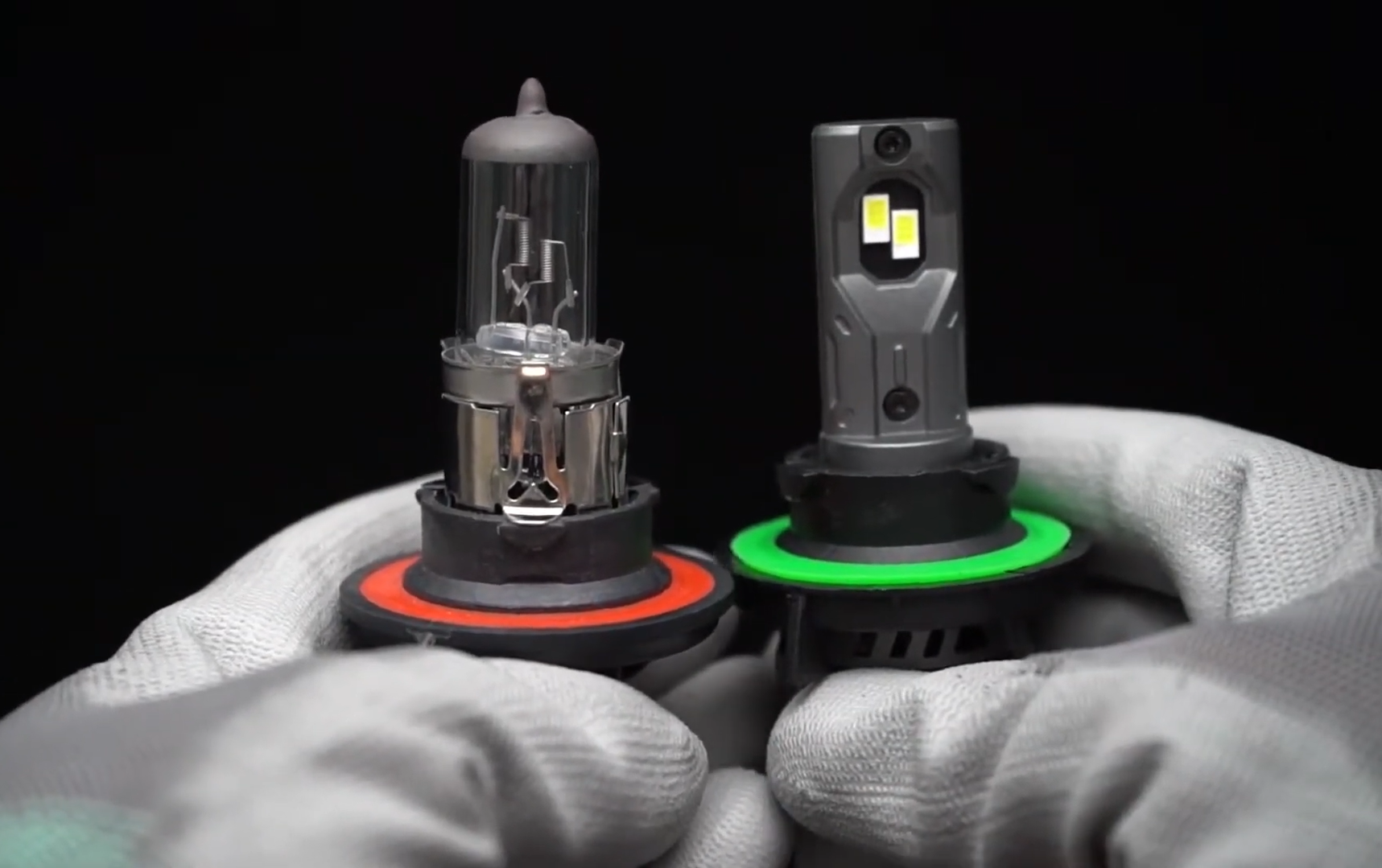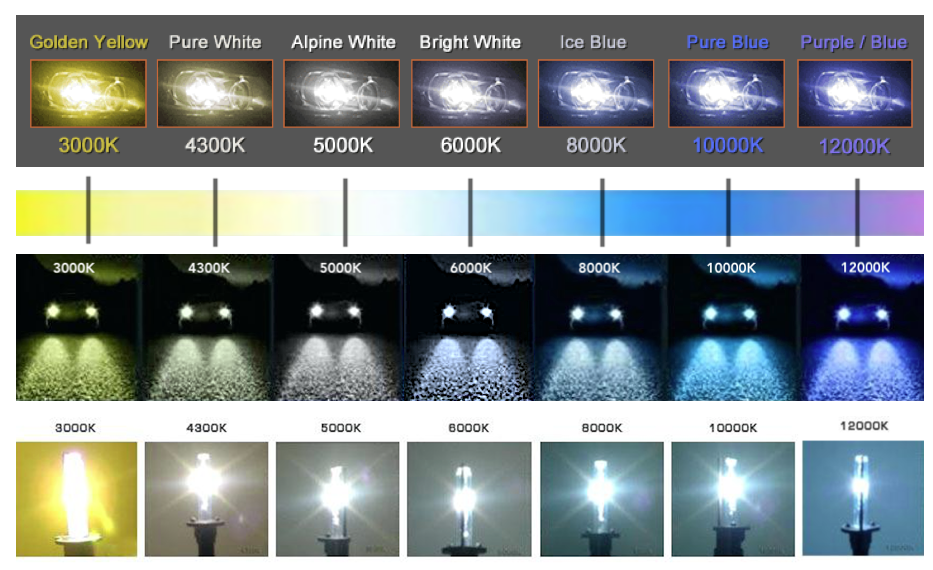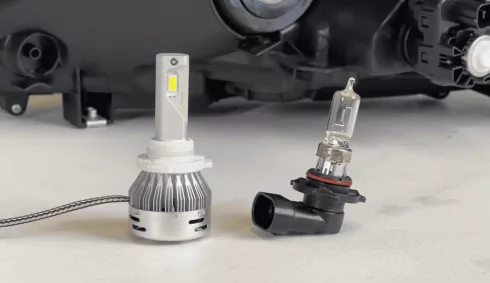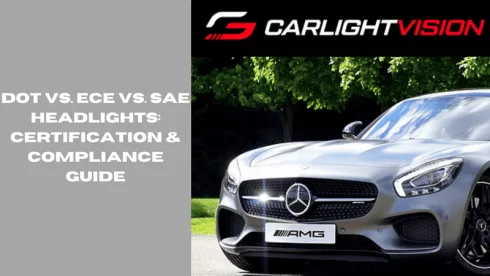Your nighttime visibility on the road is directly linked to the performance of your headlamps. The brighter they are, the better you’ll see. And more often, you’ll have to resort to aftermarket lights as the stock headlamps are only so bright. That’s why we’re going to find the best and brightest bulbs on the market in this article.
So, what are the brightest headlight bulbs? Do they really offer the edge over our stock parts? What are the advantages, and what’s at stake? Let’s find out.
Understanding Headlight Bulbs
Headlight bulbs are the light-producing components housed within a headlight module. They can be removed and attached like a regular household bulb. Several types of headlight bulbs are available, each offering unique benefits.

When headlight bulbs draw power from your car, they pass the electricity through their filaments or diodes. In filamentous bulbs, the filament heats up and produces bright light. The inert gas (Halogen/Xenon) determines the brightness, nature, and colour of the beam. In the LED bulbs, electrons pass through the p-n junction of the semiconductor and release photons as energy.
Xenon headlight bulbs are significantly brighter than other bulb types, more so than LED headlight bulbs. They can generate a whopping 10,000 lumens, ten times brighter than standard Halogen bulbs and four to five times brighter than LED bulbs.
When choosing a headlight bulb, consider factors such as brightness, colour temperature (the colour of the light), and how long the bulbs are likely to last. The right choice will depend on your driving needs and preferences.
Headlight Housing
Reflector Housing, used primarily before 1985, consists of a reflective surface positioned behind the bulb to direct and distribute light. This design scatters light from a reflector headlight in a focused beam by bouncing it off the reflector’s curved surface, making the light brighter and more practical compared to the bulb alone. While reflector housing is cost-effective and provides comprehensive coverage, it offers less precise light control and can cause glare for oncoming drivers. Reflector headlights are typical in older and budget-friendly vehicles.
Projector Housing, introduced in the 1980s, utilizes a dedicated lens system to create a sharp, well-defined beam of light. The projector lens focuses light more precisely than reflector housing for improved visibility and reduced glare for other drivers. This design enhances light distribution and driving safety but comes at a slightly higher cost. Projector headlight housing is now standard in newer cars, luxury vehicles, and performance models.
Halogen Bulbs

Halogen bulbs are the most common type of headlight bulb. When electricity passes through a tungsten filament enclosed by Halogen gas, the filament heats up and produces light. These bulbs are affordable and easy to replace. Due to their simplicity and cost-effectiveness, they’ve been a popular choice for many drivers. However, Halogen lights tend to have a shorter lifespan and lower brightness compared to other types.
Advantages:
- Affordability: These lights are the most cost-effective option.
- Easy Replacement: They are simple to install and replace.
Disadvantages:
- Shorter Lifespan: Typically lasts around 1,000 hours.
- Lower Efficiency: Less energy-efficient compared to LED and HID bulbs.
- Short Range: Only about 80-100 feet.
- Yellowish Light: Produces a warmer, less intense light that can be less effective for night driving.
LED Bulbs

LED (Light Emitting Diode) bulbs are known for their energy efficiency and long lifespan. They produce a bright, white light and are more durable than halogen bulbs. Aftermarket LED bulbs are becoming increasingly popular in modern vehicles thanks to their low power consumption and high performance. They are often more expensive upfront but can save money in the long run as they outlast most other headlamps.
Advantages:
- Energy Efficiency: An LED headlight bulb consumes less power compared to halogen and HID bulbs.
- Long Lifespan: Lasts between 30,000 and 50,000 hours.
- Bright, White Light: Provides superior visibility at night with a cooler, more daylight-like colour.
- Range: Depending on the model, these lights will illuminate 200-300 meters ahead.
Disadvantages:
- Higher Initial Cost: Higher upfront cost compared to halogen lights.
- Complex Installation: LED headlights may require additional components or modifications depending on the vehicle.
Xenon HID Bulbs

Xenon High-Intensity Discharge (HID) bulbs produce a bright, white-blue light that mimics daylight. They provide a higher lumen output than halogen bulbs, offering better visibility at night. HID bulbs are more energy-efficient than halogen but less so than LED. They can be more expensive and may require a specialized system to install in some vehicles.
Advantages:
- High Brightness: Delivers a very bright light that enhances visibility.
- Longer Lifespan: Typically lasts between 2,000 and 10,000 hours.
- Distinctive Glow: Produces a cooler, bluish-white light that improves nighttime visibility.
Disadvantages:
- Cost: Higher price compared to halogen bulbs, though generally less than LEDs.
- Complex Installation: Often requires a ballast and may need professional installation.
- Potential Glare: An HID headlight bulb can cause glare for other drivers if not correctly aligned.
What Makes the Brightest Bulbs
Lumen Output and Brightness
Lumen output is a key factor in determining the brightness of a headlight bulb. It measures the total amount of visible light emitted by the bulb, with higher lumen values indicating greater brightness.
When choosing headlight bulbs, selecting ones with higher lumen output can significantly improve your visibility on the road, especially in dark or adverse weather conditions.
In general, Halogen bulbs produce about 1,000 lumens, LEDs 2,000 to 10,000, and Xenons about 4,500 max.
Here’s a for Lumens and Wattage for a better portrayal of power efficiency.
| Bulb Type | Lumen Output (Range) | Wattage (Range) | Efficiency (Lumens per Watt) |
|---|---|---|---|
| Halogen Bulb | 700 – 1,500 lumens | 55 – 65 watts | 12 – 25 lumens per watt |
| LED Bulb | 2,000 – 10,00 lumens | 25 – 85 watts | 80 – 120 lumens per watt |
| Xenon HID Bulb | 2,000 – 4,500 lumens | 35 – 50 watts | 60 – 90 lumens per watt |
It’s important to balance brightness with other factors, such as ensuring that the light isn’t so bright that it blinds oncoming drivers. Some regions have regulations on the maximum allowable lumen output for headlights, typically around 3,000 lumens and not less than 500 lumens. So, it’s also a good idea to check local laws when upgrading to brighter bulbs.
Understanding Color Temperature:
Headlight colour temperature refers to the hue and appearance of the light emitted by the bulbs. We measure it in Kelvin (K). It determines the colour of the light, ranging from warm yellow to cool blue tones.

- Lower Kelvin (3000K-4000K): This range produces a warm, yellowish light, similar to traditional halogen bulbs. While this type of light can be easier on the eyes in fog or snow, it may not offer the best overall visibility.
- Mid-Range Kelvin (5000K-6000K): This produces a bright white light that closely resembles daylight. Light in this range provides excellent visibility and colour contrast, making it easier to see road signs, obstacles, and other vehicles. As a result, it’s often considered safer for night driving.
- Higher Kelvin (6000K-7000K and above): This range produces a bluish-white beam. While these bulbs may look stylish, they can sometimes cause more glare, which might be uncomfortable for oncoming drivers and less effective in certain weather conditions, like heavy rain or fog.
Colour Temperature and Safety:
- Visibility: Whiter light (5000K-6000K) enhances visibility by improving contrast and clarity. This can help drivers spot hazards more quickly and reduce eye strain during long night drives.
- Colour Perception: Higher colour temperatures (whiter light) also improve colour perception and make it easier to distinguish different colours on the road, such as traffic signals and road signs.
- Weather Conditions: In fog or rain, very high colour temperatures (above 6000K) might not perform as well because they can cause more glare. In these situations, slightly lower colour temperatures (around 4500K-5000K) might be more effective.
Top Picks for Best and Brightest Headlight Bulbs
Plug-and-Play LED Headlight Bulbs

Carlightvision LED Headlight Bulbs are designed to deliver exceptional brightness, significantly improving road visibility during night driving. These bulbs offer a focused, bright beam that enhances overall safety. With a lifespan of up to 50,000 hours, they are reliable for long-term use. Their cool white light, around 6000K, mimics daylight and provides clear visibility while reducing eye strain, making them ideal for nighttime driving.
Krieges LED Headlight Bulbs provide up to 12,000 lumens of brightness, ideal for drivers seeking maximum illumination for safer night driving. They last approximately 30,000 hours, offering durability, and with a color temperature of 6500K, they provide bright, white light that enhances road visibility and contrast.
Alla Lighting LED Headlight Bulbs are known for their high lumen output, enhancing visibility in low-light conditions. They have an estimated lifespan of 30,000 hours, making them a cost-effective option. The 6000K color temperature offers clean, white light for better road clarity and visibility.
Xenon HID Headlight Bulbs for Enhanced Safety
Carlightvision Xenon HID Bulbs are known for their powerful light output, producing an intense bluish-white beam that improves visibility in various driving conditions. Made out of high-quality materials, these bulbs typically last 2,000 to 3,000 hours, making them a strong choice for superior illumination. With a color temperature range between 5000K and 6000K, they provide a bright, clear light that enhances safety, especially in poor weather conditions.
Osram XENARC D3S bulbs offer high-intensity light output, enhancing road illumination and driving safety. With a lifespan of around 3,000 hours, they deliver reliable performance. Their color temperature ranges from 4300K to 6000K, providing bright, clear light that reduces glare and enhances visibility.
Philips Xenon HID Bulbs are recognized for their powerful light output, ensuring better road visibility. With a typical lifespan of around 3,000 hours, they are a durable choice for headlight upgrades. Their color temperature ranges from 4800K to 6000K, providing excellent illumination for improved safety.
Other Market Competitors
Sylvania SilverStar Ultra halogen bulbs are known for their bright, clear light and improved visibility over standard halogens, making them a good option for those seeking performance at an affordable price. Hella +50 Performance Bulbs offer a budget-friendly halogen option with a bright light and modest visibility improvement. PIAA Xtreme White Bulbs are premium halogen bulbs, offering bright, white light for enhanced visibility and a stylish appearance.
Specialized Headlight Bulbs for Specific Needs
Off-road driving and White Headlights
White headlights, particularly those around a 6000K color temperature, mimic daylight for enhanced clarity during nighttime driving. These headlights provide a crisp, bright beam that makes road signs, lane markings, and obstacles more visible. They’re also beneficial at reducing eye strain during long drives. LED and HID (High-Intensity Discharge) bulbs are commonly used to achieve this bright, white light.
LEDs offer instantaneous full brightness, while HIDs have a broader light spread. Both options perform exceptionally well in urban and suburban settings, where clear illumination is crucial to navigating dimly lit streets, intersections, or busy highways.
Long-Lasting Options for Reduced Maintenance
For drivers looking to reduce maintenance and the hassle of frequent bulb replacements, LED and HID bulbs stand out as long-lasting options. LED bulbs, in particular, are known for their incredible lifespan, often lasting up to 25,000 hours or more. This makes them ideal for vehicles that require consistent and reliable lighting without the frequent need for replacements.
HIDs also offer a longer lifespan than traditional halogen bulbs, though slightly less than LEDs. Both types are more energy-efficient, drawing less power from the vehicle’s electrical system. This efficiency, combined with their durability, makes them a cost-effective, low-maintenance option that enhances both performance and reliability over time.
Key Parameters to Consider
When choosing headlight bulbs, you should focus on a few important factors to ensure good performance and safety. Here are the key areas to consider:
1. Brightness, Beam Pattern, and Color
The brightness of headlight bulbs is measured in lumens, and higher lumens mean more light for better visibility in poorly lit areas. However, check local laws about legal brightness limits. The beam pattern is equally important, as it determines how the light spreads on the road.
A well-focused beam improves visibility without blinding other drivers. Color temperature, measured in Kelvin (K), affects the color of the light. Cooler temperatures (5000K and above) produce whiter or bluish light, which may offer better clarity, while warmer temperatures (around 3000K) emit a yellow light.
2. Durability and Heat Management
You want headlight bulbs that last and LED and HID bulbs generally have longer lifespans compared to halogen bulbs. It’s also important to consider heat dissipation, especially for LEDs and HIDs, which can get hot. A bulb with a built-in fan or a heat sink can smoothly manage heat and extend its life.
Also, consider choosing bulbs with features like waterproofing and dust resistance, which make them more durable in harsh weather conditions.
3. Compatibility and Installation
Make sure the bulb you choose fits your vehicle’s headlight housing and works with your car’s electrical system. You can find this information in your vehicle’s manual or by consulting a professional. While some bulbs, like halogen and LED, are easy to install on your own, others, like HIDs, may require professional installation due to their complexity.
4. Efficiency, Cost, and Legal Compliance
Energy efficiency is another factor, with LED bulbs being the most energy-efficient. Although LED and HID bulbs tend to be more expensive than halogen bulbs, they provide better performance and last longer. Additionally, be aware of legal requirements in your area, especially regarding brightness and color. You don’t want to choose bulbs that violate local regulations and risk fines.
5. Brand, Warranty, and Additional Features
It’s smart to go with bulbs from reputable brands known for quality. Reading reviews or getting recommendations can help you make the right choice. Look for bulbs that come with a good warranty, as it indicates durability and can give you peace of mind.
Some other features to consider include UV protection to prevent headlight lens yellowing and the Color Rendering Index (CRI), which affects how accurately the light renders colors. Higher CRI can help you see objects and road signs better at night.
Conclusion
Choosing the Right Headlight Bulbs for Your Needs
When choosing headlight bulbs, focus on lumen output, colour temperature, and durability to match your driving needs. Opt for brand products like Carlightvision, Philips, OSRAM, or SEALIGHT to ensure high-quality performance and reliability. Remember, it’s your call. Surf the market and check user reviews on the product you’re eyeing.
For more personalized recommendations and expert guidance, visit Carlightvision. We offer a diverse set of premium headlight bulbs for your vehicle here as well. Don’t hesitate to take a look!




